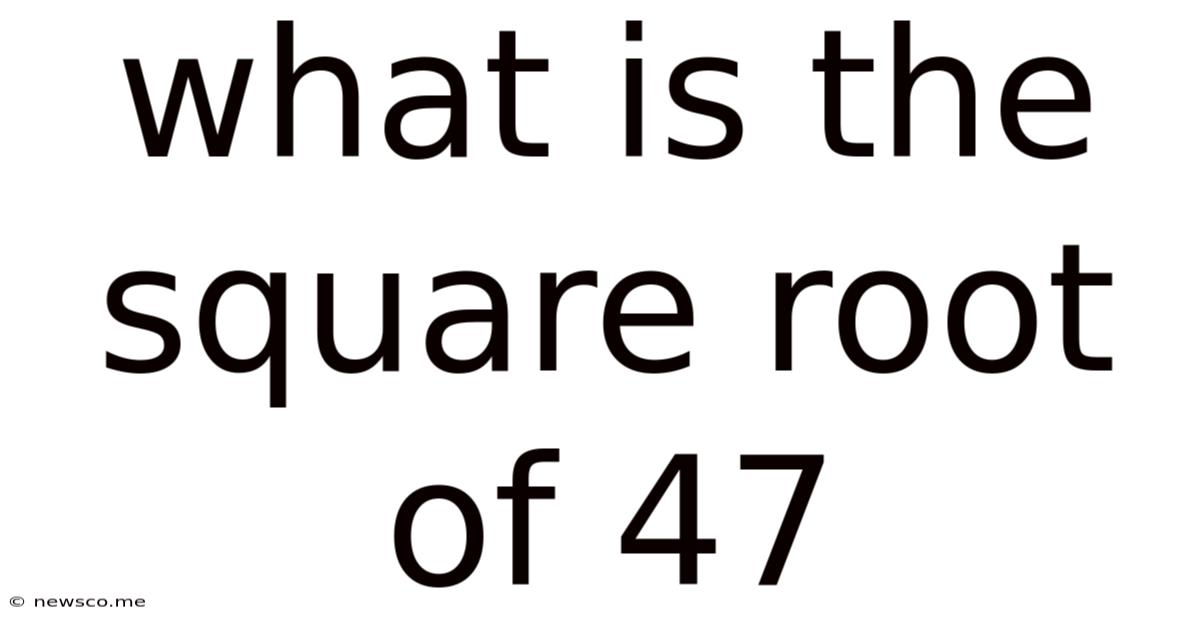What Is The Square Root Of 47
News Co
Apr 04, 2025 · 4 min read

Table of Contents
What is the Square Root of 47? A Deep Dive into Approximation and Calculation
The seemingly simple question, "What is the square root of 47?" opens a door to a fascinating exploration of mathematical concepts, calculation methods, and the nature of irrational numbers. While a quick calculator search reveals an approximate decimal value, understanding how that value is derived and what it represents is far more enriching. This article delves into the intricacies of finding the square root of 47, exploring various approaches and highlighting the beauty of mathematical precision.
Understanding Square Roots
Before we tackle the square root of 47 specifically, let's establish a foundational understanding of square roots. The square root of a number, denoted by the symbol √, is a value that, when multiplied by itself, equals the original number. For example:
- √9 = 3 because 3 * 3 = 9
- √16 = 4 because 4 * 4 = 16
However, not all numbers have perfect square roots – meaning integers that, when squared, produce the original number. 47 falls into this category. Numbers like 47, whose square roots are not integers, have irrational square roots. This means their decimal representation continues infinitely without repeating.
Methods for Approximating √47
Since 47 isn't a perfect square, we need to employ approximation methods to find its square root. Several techniques exist, ranging from simple estimation to sophisticated algorithms.
1. Estimation through Perfect Squares:
The simplest method involves identifying the perfect squares closest to 47. We know that 6² = 36 and 7² = 49. Since 47 lies between 36 and 49, its square root must lie between 6 and 7. This gives us a rough initial estimate. We can refine this estimate by observing that 47 is closer to 49 than to 36, suggesting that √47 is closer to 7 than to 6. A reasonable initial guess might be 6.8 or 6.9.
2. Babylonian Method (or Heron's Method):
This iterative method refines an initial guess to get progressively closer to the true square root. The formula is:
x<sub>n+1</sub> = ½ (x<sub>n</sub> + a/x<sub>n</sub>)
Where:
- x<sub>n</sub> is the current guess
- x<sub>n+1</sub> is the improved guess
- a is the number whose square root we're seeking (in this case, 47)
Let's use our initial guess of 6.8:
- x<sub>1</sub> = 6.8
- x<sub>2</sub> = ½ (6.8 + 47/6.8) ≈ 6.85588
- x<sub>3</sub> = ½ (6.85588 + 47/6.85588) ≈ 6.85565
As you can see, with each iteration, the value converges towards the actual square root. Continuing this process several times yields a highly accurate approximation.
3. Newton-Raphson Method:
Similar to the Babylonian method, the Newton-Raphson method is an iterative approach to finding roots of equations. For finding square roots, it can be formulated as:
x<sub>n+1</sub> = ½ (x<sub>n</sub> + a/x<sub>n</sub>)
Notice that this is identical to the Babylonian method. Therefore, the same iterative process applies, leading to a highly accurate approximation of √47.
4. Using a Calculator:
Modern calculators are equipped to compute square roots directly. Simply input 47 and press the √ button to obtain an approximate decimal value, typically accurate to several decimal places. This is the most convenient method but doesn't provide the same level of understanding of the underlying mathematical processes.
The Irrational Nature of √47
As mentioned earlier, √47 is an irrational number. This means its decimal representation neither terminates nor repeats. No matter how many decimal places we calculate, we'll never reach an exact representation. This is a fundamental property of irrational numbers and highlights the infinite nature of mathematical concepts.
Practical Applications and Significance
While calculating the square root of 47 might seem abstract, the concept of square roots has widespread applications in various fields:
- Physics: Calculating distances, velocities, and accelerations often involves square roots.
- Engineering: Designing structures, calculating forces, and analyzing stress require understanding square roots.
- Computer Graphics: Rendering and manipulating 3D objects rely heavily on square root calculations.
- Statistics: Standard deviation and variance calculations often involve the use of square roots.
- Finance: Compound interest calculations and investment growth models incorporate square roots.
Conclusion: Beyond the Number
The square root of 47 is approximately 6.8556546. However, the journey to finding this approximation is much more significant than the final answer itself. It highlights the power of iterative methods, underscores the nature of irrational numbers, and demonstrates the ubiquitous applications of square root calculations in numerous disciplines. Understanding these underlying principles extends far beyond the simple act of obtaining a numerical answer; it builds a deeper appreciation for the elegance and power of mathematics. The quest to find the square root of 47, therefore, is a microcosm of the broader mathematical landscape, a testament to the beauty of approximation, and a reminder of the infinite possibilities within seemingly simple problems. Further exploration into the complexities of numerical analysis and approximation techniques will only deepen one’s understanding and appreciation of this seemingly simple yet profoundly significant mathematical concept. The iterative methods mentioned offer a pathway to a highly accurate solution, making them invaluable tools not only for understanding √47 but also for tackling more complex mathematical problems.
Latest Posts
Related Post
Thank you for visiting our website which covers about What Is The Square Root Of 47 . We hope the information provided has been useful to you. Feel free to contact us if you have any questions or need further assistance. See you next time and don't miss to bookmark.